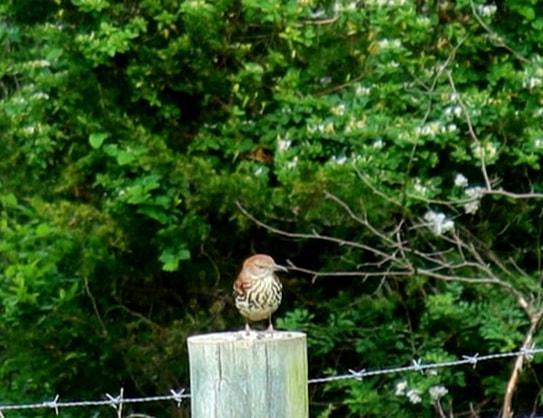 Sycamore Grove Farm, Madison County It took me a while until I saw my first Brown Thrasher (Toxostoma rufum) on our farm. I was hearing them and picking them up on Merlin. But it wasn’t until recently that I actually saw one. They are often hidden in and under thick shrubs, where they sing discrete musical phrases, often repeating them twice. The male Brown Thrasher has the largest documented song repertoire of all North American birds, with over 1,100 song types. Some sources state that each individual has up to 3,000 song phrases, while others stated beyond 3,000. While not having as diverse a “song book” as the Northern mockingbird, thrashers are also noted for their mimicry. During the breeding season, the male's mimicking ability is at its best display. It can impersonate the calls of Tufted Titmice, Northern Cardinals, Wood Thrushes, and Northern Flickers. So you have to be careful: if you don’t actually see some of these other birds and their song comes up on Merlin - maybe it’s actually a very talented thrasher! Thrashers don’t have a long life span: only about 34% live through their first and second year, and about 50% make it through to their third year. The longest known lifespan in the wild is 12 years. The thrasher’s distinctive curved bill has been noted for its flexibility in catching quick insects. Scientists have determined that this flexibility is due to the amount of vertebrae in its neck, which exceeds giraffes and camels. Thrashers defend themselves by using their bill, which can inflict significant damage to species smaller than them, along with wing-flapping and vocal expressions. The name “thrasher” is believed to have come from the thrashing sound the bird makes when digging through ground debris. I have frequently seen their feeding behavior where they turn over leaves, small rocks and branches, looking for insects and nuts. Scientists have also found bones of lizards, salamanders, and frogs in the stomach of thrashers. So they have a very eclectic diet. The thrasher name is also thought to come from the thrashing sound that it makes when it is smashing large insects to kill and eventually eat them. When feeding, the Brown Thrasher can hammer nuts like acorns in order to remove the shell. Scientists have observed thrashers digging a hole about 1.5 cm (0.59 in) deep, place an acorn in it, and hit the acorn until it cracked – almost like a form of tool usage. So enjoy these talented song birds and the role they play in nature. Happy birding! Charlene
0 Comments
Your comment will be posted after it is approved.
Leave a Reply. |
Have a blog or blog idea?
Let us know (click) Other Blogs
VA Native Plant Society - click Brenda Clement Jones - click John Muir Laws' Blog - click Megan's Nature Nook - click Categories
All
Archives
September 2023
Blog Administrator:
Kathleen A. VMN since 2018 |